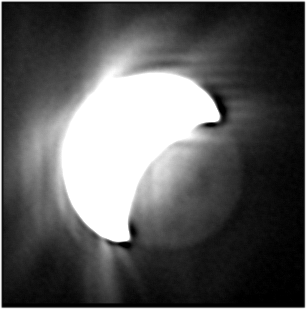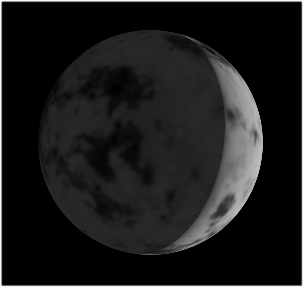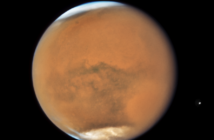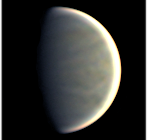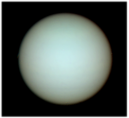One of the most fascinating planetary observation that you can make is imaging the surface of Venus, a planet however completely covered by a permanent layer of bright clouds. Or to say it better, you can image the thermal signal of the surface…
Since the 80’s/90’s and the work done at the Pic du Midi, we know that the thermal emission from the surface of Venus is visible from Earth. Its ground is heated at more than 400°C and emits an infrared signal around 1 micron, a wavelength barely accessible to amateur CCD’s. More over, the carbon dioxide gas (CO2) that makes 96 % of the Venusian atmosphere is translucent precisely around 1 micron! This thermal signal is then able to escape to space… At left is the best image I have obtained on 2004 May, 16th, with a C14 and an ATK-1HS.
Of course this must be done on the night side… this is why you must wait for the phase to reach the crescent state.
We are about to get two windows of imaging around the inferior conjunction of January 2014, in December and January-February of next year.
It will be the last chance until 2015!
When should you observe?
You must take care of various parameters:
- The phase must be narrow enough for the surface to be seen, or the bright day-side crescent will saturate the whole image. A maximum phase would be around 20 %. The signal could be detected at more than 20 %, but at this value and under we are going to see details as well.
- The planet must not be too low. An altitude of 10/15° is fine but it will still be observable below (with the amateur equipment, the observation must be done after sunset).
- Above all… The Sun must be at least at 5° below the horizon, or the sky background will remain too bright. You can find the altitude of the Sun for your location with WinJupos.
With all of this you have two chance to be successful:
- from December 12th, 2013, until around the new year
- from the end of 2014 January to the 10th of February.
For observers in the northern hemisphere the first period (December) is more favorable as the planet will be a bit higher above the horizon. Below are my observations from December 18th, 2005 (with a Mewlon 210), a Venusian eastern elongation identical to that of 2013:
How to observe?
The observation is not that complicated but you will have to master seriously the imaging technique.
- First of all you need a 1 micron infrared filter. The band of light is narrow and more usual filters such as a 800 nm one will fail to reveal this.
- Then a telescope of at least 200 mm. Some observers have been successful with inferior diameters, but at 1 micron the resolution of your telescope is divided by 4! And 200 mm must be the smallest diameter able to catch details.
- The sampling is very important: the reduced resolution and the weak thermal signal make long focal length uninteresting. F/D ratio of to 12/13 will be perfect.
- The exposure time will be long (for planetary imaging ;) ); around a few seconds (5 to 10). Launch the video as soon as the thermal image is becoming visible and let it run until the planet disappear or until the seeing get too bad. There is no risk of blurring since it takes 243 terrestrial days to the solid surface to complete one turn!
Dark patches inside the thermal image…
Dark patches are observables inside this glow. They correspond to the mountains of Venus, that are less cold and emit less infrared light.
In December 2013, like in May 2004 and 2012, we will observe the thermal signal of Phoebe Regio and Beta Regio (read the EPSC 2013 Venus conference with G.Monachino). Thanks to observer John Boudreau, WinJupos now can simulate the thermal emission on the night side!. You can access the map in the “options” of the ephemerides (VenusThermalEmission1micron.jpg). The map settings are:
– simple cylindrical projection
– North at top, normal view
-Longitude of left maring at 0° in system I
– Set “unillum. surface” on the Graphics.
Simulation of the thermal signal for December 15th, 2013.

